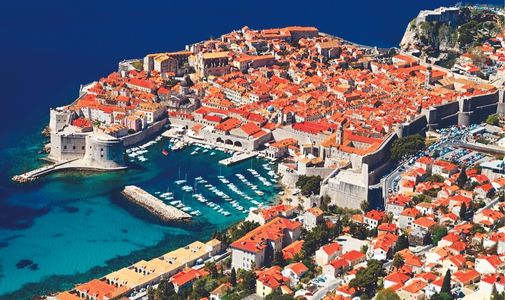As an international real estate scout and investor, I’ve looked at a lot of real estate. But the most impressive location I’ve ever seen was on a scouting trip to Croatia (I’m returning there this fall).
It was protected by 17 towers, five bastions, three fortresses, walls that are 20 feet thick, and a moat that was once armed with more than 120 cannons. I’m talking, of course, about the medieval city of Dubrovnik.
It’s one of the only medieval cities in Europe that was never penetrated by a hostile army (though many have tried). Even as recently as 1992, during the Croatian War of Independence, the city proved unbreachable. It’s perhaps the most successfully defended city in all of history. And it exemplifies why the business analogy of the “moat” is such a potent one.
Made famous by investor Warren Buffett, a “moat” in the business sense is anything that can give you a sustained advantage over your competition.
This competitive advantage can take many forms. It can be a cost advantage, whereby you can undercut the prices of any competitor. It can be a size advantage, which gives you economies of scale. It can be a unique technology or an original patent. Or your moat can be high switching costs within your industry (we all know the pain of switching between insurers and cellphone carriers). Whatever it is, a moat is essential to a great long-term investment of any kind.
Dubrovnik has a literal moat, of course, but it also has an economic one. As a real estate investor, I love historic cities, they offer something truly rare. Within their walls there is a limited supply of historic properties that can never be reproduced. In Dubrovnik, the compact city is hemmed in by medieval walls. There is no space to build and even if there was it would be impossible thanks to the city’s UNESCO World Heritage site status. At the same time, tourism to the city has been booming for two decades, hitting almost 1.5 million visitors in 2019. That’s a lot for a city of just 42,000 people. Limited supply collided with high demand and real estate prices exploded.
The best time to buy in Dubrovnik was back in 2001, when Croatia started popping up on the radar of international tourists. When I visited in 2005, it was still a good time to buy, even though prices had already seen a big run. Today, thanks to its moat, real estate in the historic city is downright expensive, even by Western European standards. But that’s not to say prices won’t continue to climb…
That’s why moats are so important when assessing the profitability of any real estate opportunity. Of course, your moats need to be protecting something desirable, useful, and valuable. But the more of them you have, the better chance you have of seeing a strong profit when demand starts to rise. The best-in-class real estate I bring to members of my Real Estate Trend Alert group is a good example. We buy in inherently desirable places, with strong demand, in communities delivered by the best developers. And with our moats, we can turn that into stellar gains.
Geographical Moat
If you look at the most expensive real estate in the world, it all has two things in common. It’s in short supply and it’s in high demand.
Take Manhattan. This year, the average sale price of a home in Manhattan was $1.28 million. The reason it’s so high is not because of the quality of homes, it’s because there is such huge demand to own in one of the world’s biggest cultural and economic hubs. Crucially, because Manhattan has limited space (it’s on an island), building here has become extremely expensive and prohibitive, sending prices of existing real estate skyrocketing.
Limited supply and high demand are crucial. And if you own real estate in a location with these two things, you can make a killing—especially if demand is still growing. Ideally, you want to find an opportunity where the supply is naturally restricted by lack of space to build—like Manhattan or Dubrovnik. This is what I call a “geographical moat.” It’s an essential element in many of the RETA deals I bring to the table. For instance, a major geographical moat underlies many of the deals in Tulum on the Riviera Maya that I brought to my RETA members.
Just last October members had the chance to own luxury two-bedroom condos in a community called Samsara with an unbeatable RETA-only price starting from $198,600. The land where this new community is set is unique. It’s a quiet and exclumarketsive enclave off the main drag, yet close enough to get to the white-sand beach and town in about 10 minutes.
The famed Maya ruins that put Tulum on the map and that host 2 million visitors each year are just to the north. And across the street from Samsara is the national park that acts as a buffer zone around the ruins and as a nature preserve…all the way to the beach. Nobody can build in this protected zone. It is a geographic moat that should keep this enclave (hemmed in by jungle) high-end and desirable as Tulum develops further.
Furthermore, to the south of town is the Sian Ka’an Biosphere—over a thousand square miles of UNESCO-protected wetlands, jungle, and wild coast. Given all those barriers, finding something as secluded and private as Samsara is rare. There are plenty of projects in bad or average locations in Tulum, but there is a limited supply of the right type of developable land here for top-notch communities.
But limited supply in itself is not enough to drive values up. There needs to be high demand too…and in Tulum demand is booming. A recent survey from travel booking site Expedia named Tulum—and the wider Riviera Maya—one of the most searched destinations by travelers for 2022.
On top of that is another growing market: the work-from-home set that are part of what my team and I have taken to calling the “Zoom Boom.” These are folks that stay for months, even years at a time, and they all need somewhere to live.
That’s what makes Samsara so appealing. There are no other condos like these available. It has incredible amenities and even beach club access with a private shuttle bus. With that moat around it too, I expect a community like this to be a rare commodity for years to come.
In fact, it is already helping to drive prices up. I recently saw an ad for a two-bedroom condo in Samsara listed at $298,200. When I brought this to RETA members, they could own similar condos at an exclusive off-market price of just $212,300. That’s a boost of $85,900 in just nine months.
Insider Knowledge and Industry Contacts
Moats don’t always need to be physical attributes…
To go back to the example of Dubrovnik: What’s often overlooked is how well the city-state used diplomacy to defend itself. In fact, it was so good at placating its enemies that most of the time its great walls were not necessary. They negotiated treaties, paid tributes, and expanded their influence beyond the Adriatic.
My point is, the connections you make and the influence you can wield is just as important as knowing where to buy. It gives you the inside track on what’s really going on and opens up opportunities that aren’t available to most real estate buyers.
That’s why I spend six months of the year on the road scouting and creating contacts. Along with my team, we spend close to a million dollars on travel and research. And it’s worth it. Each new industry contact we make has the potential to deliver incredible profits to RETA members through the deals they can bring. This dedication to building a network of insiders is something few other real estate investors do.
A moat is essential to any long-term investment.
This gives us a remarkable competitive advantage when it comes to finding the best deals and working with the best people. For instance, in Costa Rica’s Southern Zone, we get access to members-only deals because we deal with the preeminent developer in the region. She arrived in the Southern Zone in the 1980s and has since created the best-in-class community there.
Her long track record in the Southern Zone is a moat that keeps her competitors at bay. She bought land at agricultural prices, before the new roads and highways opened the area up. And, she’s made the connections, accrued decades of experience, and figured out how to get the permits and approvals needed to develop. A newbie developer trying to break into the market today simply can’t compete.
Having such industry contacts can give you an extraordinary edge—deals and pricing that no one else sees—and ensure you’re getting a best-in-class product. Another moat that can boost profit. For instance, last month, I got news about a deal RETA had on premium oceanview lots in the Southern Zone in 2018. A similar lot to those RETA members could snap up for $147,980 was going for $211,422. That’s a boost of more than $63,000 in less than four years.
Group Buying Power
If you’ve ever shopped at Sam’s Club, you know that buying in bulk means big savings. In much the same way, members of my RETA group can save big on real estate. This is possible because the combined group buying power of RETA members creates the opportunity to buy real estate in bulk.
It’s a win-win for both buyers and the developer. The developer sells a large chunk of their inventory right off the bat and in return they hand buyers big juicy discounts…ensuring they pay way less than anyone else.
I call this the “RETA edge.” It’s an incredibly rare moat to have. The kind of competitive advantage that’s usually reserved for billion-dollar investment firms. But at RETA, members use it just as effectively.
Take an example in Cabo San Lucas on Mexico’s Baja California Peninsula. In August 2021, I brought RETA members an opportunity on two-bedroom ocean-view condos from just $188,200. This past May, the developer listed condos in the same community for $130,000 more than RETA members paid.
Members used our group buying power moat to get in way below what anyone else was paying. And by doing so, it set them up for exceptional gains down the line. With many of our RETA deals we have multiple moats at play. A geographical moat, our insider contacts, and group buying power. More recently, rising inflation has handed us another moat, making our RETA deals even more valuable. Inflation restricts supply of new real estate and makes future supply even more expensive to produce. This is good for RETA members who are already sitting pretty on recent opportunities across our beat. It’s one more driver of profits in the months and years to come.
 Ronan McMahon is the editor of Real Estate Trend Alert and a contributing editor to IL. He spends at least six months a year crossing the globe in search of the best real estate deals worldwide.
Ronan McMahon is the editor of Real Estate Trend Alert and a contributing editor to IL. He spends at least six months a year crossing the globe in search of the best real estate deals worldwide.

